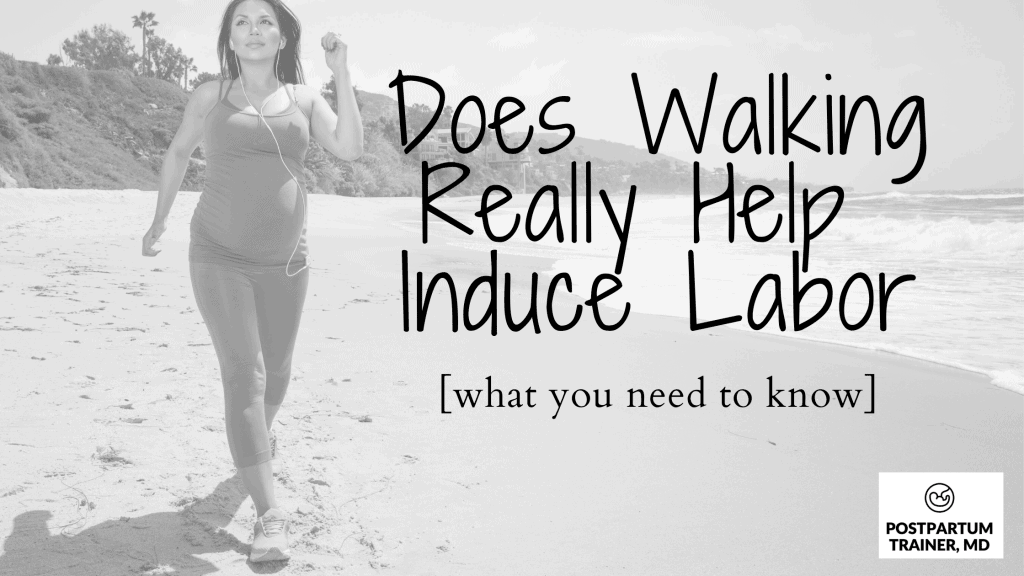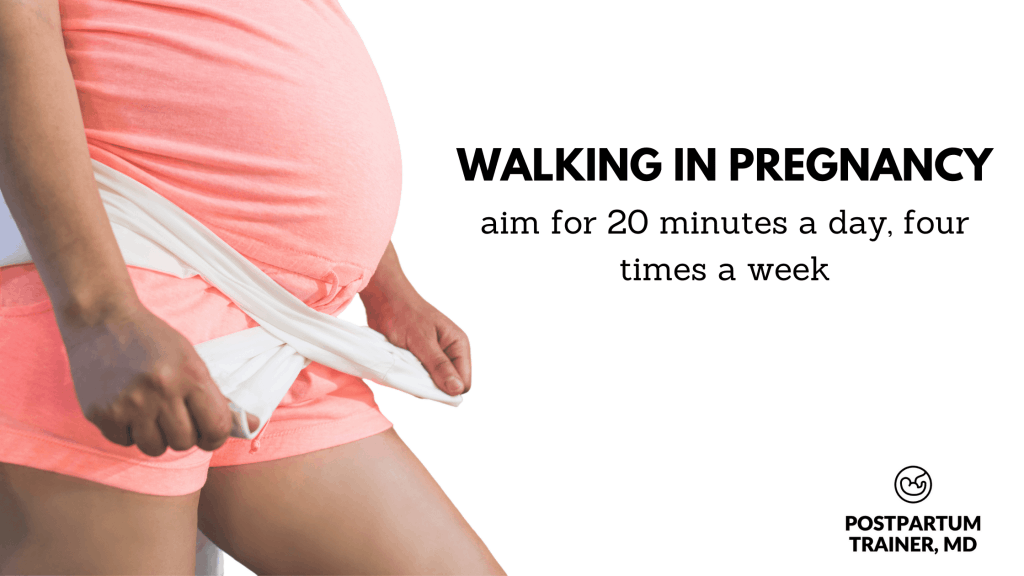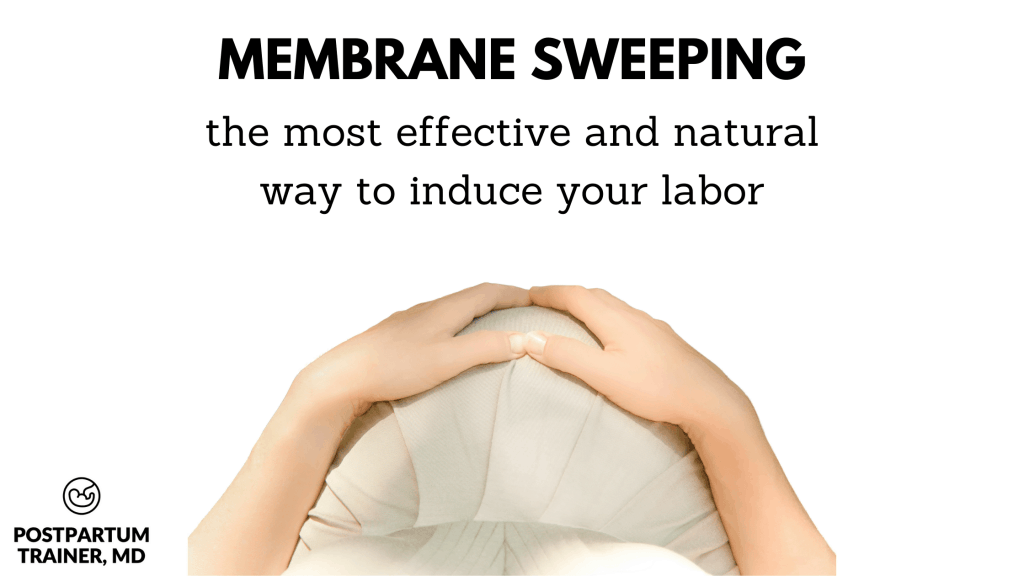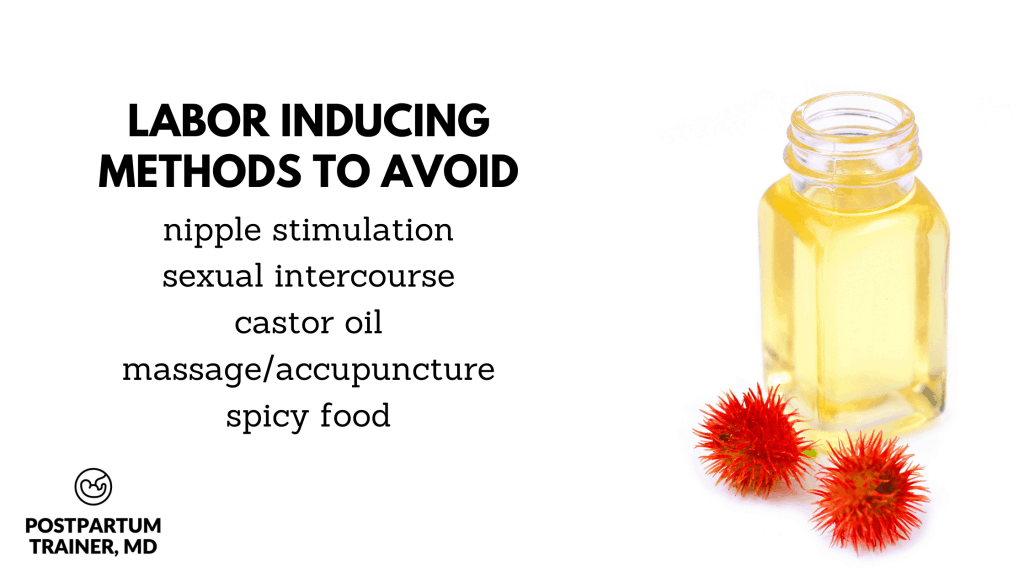So you’re 39 weeks pregnant and you’ve heard that walking can help induce labor?
It’s a very common belief.
In fact, OBGYNs will often send you “walking” if you come to the hospital in early labor.
But does it actually work?
Does walking really help induce labor?
Keep reading.

Does walking really induce labor?
From a completely scientific perspective, we can’t say for certain that walking helps induce labor.
However, a recent randomized controlled trial from 2021 found that walking 40 minutes a day four times per week starting at 34 weeks improved spontaneous labor rates in 90% of women.
It is unclear if walking will help you go into labor if you are already full term.
With that said, many women report that walking is what helped start their labor.
Why is that the case?
The most obvious reason is that walking could potentially help dilate your cervix.
Does walking help you dilate?
In a full-term pregnancy, a baby that is well engaged in the pelvis and is head down will place a lot of pressure on your cervix.
In theory, with the help of gravity, the weight of your baby can put enough force on the cervix to make it start dilating.
The 2021 study also found that the women who walked had better Bishop scores, (which is a method of grading the dilation, firmness, and position of the cervix) when compared to the women who didn’t.
So if you want to try it for yourself, speak with your doctor on how you should go about it.
What type of walking brings on labor?
There are no specific recommendations on the type of walking you should do to start natural labor.
The most important thing is to listen to your body, and start with a pace that is comfortable for you and your body.
What About Curb Walking?
Curb walking is a technique where you walk with one foot on a sidewalk (the curb) and the other foot on the road.
This uneven form of walking is said to help open your pelvis and allow your baby to descend better into the birth canal.
There are no studies confirming the effectiveness of curb walking, but it is unlikely to be harmful as long as you perform it in a safe environment.
How Much Do You Need To Walk To Induce Labor?
There is no guarantee that walking will induce labor. If you are relatively fit and have been walking regularly throughout your pregnancy, you should try to walk for 30-40 minutes per day.
However, if you aren’t very active, I suggest that you start by walking for 15-20 minutes a day, four times per week.
As you begin to feel comfortable, start increasing the time that you walk.
With that said, I don’t recommend that you go for a very long walk in the hopes of inducing labor.
Why?
Because It’s important that you don’t completely fatigue yourself needlessly. You will need your energy for when you do go into labor.
It’s also a good idea to stay in your neighborhood or walk close to the hospital just in case.
To learn more check out my post walking while pregnant.

Does climbing stairs help induce labor?
There is no evidence that climbing stairs will start labor.
You do not need to aimlessly go up and down the stairs to get contractions going.
Similar to walking, you shouldn’t fatigue yourself just to try and induce labor. Instead, walk for the benefits it can provide you throughout the pregnancy.
Can pushing induce labor?
What about bearing down? If you are actively trying to push, will that induce labor?
There is no evidence that pushing induces labor. In fact, I recommend against pushing to induce labor. Every time you bear down, you will be doing something called the Valsalva maneuver.
This Valsalva will temporarily increase your blood pressure, decrease your blood flow, and cause you unnecessary strain.
Don’t try and trick your body into something it’s not yet ready to do.
What actually triggers labor?
That is the million-dollar question. From what we understand, labor seems to be triggered by a few different things.
First of all, we know that substances called prostaglandins can help get your cervix ready to dilate.
How do we know?
Because a lot of the medications we use to induce labor are prostaglandin derivatives.
But prostaglandins are just the beginning.
We also know that the hormone oxytocin is what ultimately causes your uterus to contract and induce labor.
That’s the second medication that is often used for labor induction.
There is likely a cascade of events that happen between prostaglandin release and oxytocin release.
But that’s what we know.
To learn more about inducing labor, check out my article on What You Need to Know If You Are Being Induced.
What is the quickest way to go into labor?
The quickest and safest way to go into labor is to artificially induce labor with prostaglandins and oxytocin.
If you prefer a more natural approach, there is one labor induction technique that is the most likely to induce natural labor.
What is the most effective way to induce labor naturally?
The most effective, natural way to induce labor is known as membrane sweeping or membrane stripping.
A membrane sweep is when your healthcare provider will do a cervical exam and try to stretch your cervix and sweep the amniotic sac away from the cervix.

This can cause irritation and the possible release of prostaglandins and oxytocin.
The downside to membrane sweeping is that:
- You need to be dilated for it to be done
- It can accidentally lead to premature rupture of your membranes (aka breaking your water before the onset of labor)
- It can be quite uncomfortable
Other Common Natural Methods Women Often Try To Induce Labor
Unfortunately, there isn’t a lot of research on other quick, natural ways to go into labor.
But that doesn’t stop people from trying.
Here are a few things you may have heard other women do to start contractions:
Nipple Stimulation:
You may have heard that some women use nipple stimulation as a way to start uterine contractions.
While it does work, this is something you need to be very careful with.
Nipple stimulation is known to cause the release of oxytocin and start uterine contractions.
The problem is, there is no way to control this.
Nipple stimulation can cause you to have strong and prolonged contractions. If they are long enough, these kinds of contractions can decrease blood flow to your baby.
Reduced blood flow will lead to decreased fetal heart rate and put your baby at risk of serious fetal consequences.
In fact, nipple stimulation is sometimes used to perform what we call a “contraction stress test.” Basically, it’s a way to see how your baby tolerates contractions.
If your baby’s heart rate has a concerning drop with each contraction, that would indicate a positive test result. This means that your baby is intolerant to labor.
That’s why I don’t recommend nipple stimulation for labor induction.
Sexual Intercourse:
You may have also heard that sexual Intercourse can bring on labor.
That is for two reasons.
- There is some research to show that semen may contain prostaglandins. That’s the substance that we have been talking about that can soften your cervix.
- In addition, sex has the potential to cause uterine contractions.
The only research on sex and labor induction is equivocal. With that said, you are free to try it as long as your doctor says it is ok.
If you have placenta previa or any other condition that can lead to heavy bleeding, you must avoid intercourse!

Castor Oil:
Another common method you may have heard of is castor oil for labor induction.
Castor oil is a powerful laxative, meaning it’s will make you have several bowel movements.
Frequent bowel movements can dehydrate you, and dehydration is what can cause you to contract.
Dehydration is never a good thing. Especially during a full-term pregnancy.
Being dehydrated means you have less blood circulating.
Less circulation = less blood flow to your baby.
And we’ve already discussed that less blood flow to your baby is something you want to avoid.
Massage or Acupuncture:
Massage, acupuncture, or acupressure are other common recommendations for labor induction.
Again, there are no actual studies to prove or refute this claim.
If this is something you want to try, (and your doctor says it is okay for you to try) just make sure that you go to a clinic that has experience treating pregnant women.
Spicy Foods:
The last thing I see recommended to induce labor is spicy food.
The thought process is that these foods can irritate your gut, which may cause your uterus to contract.
It’s a similar theory to the castor oil example.
As of right now, there is no evidence that this works.
All you might get from spicy food is some heartburn.
Other Related Questions
How can I soften my cervix at home?
There are no proven or safe methods for softening your cervix at home. This is not something you want to DIY.
It’s a frequently asked question because many women know that the cervix has to soften in order for it to thin out (efface) and begin dilating.
You may have heard of women placing the herb evening primrose oil in their vaginas to try and soften the cervix.
I do not recommend inserting primrose oil into your vagina as there are no studies to confirm its safety. One randomized controlled trial found that it was ineffective at softening the cervix.
Using substances to try to induce your labor can have some negative consequences for both you and your baby.
Are there any sleeping positions to induce labor?
There are no known sleeping positions for inducing labor. As always, you should never sleep flat on your back or on your stomach in the third trimester.
Final Thoughts on Walking to Induce Labor
Whether you have a medical reason to go into labor (like going past your due date) or you are just tired of being pregnant, labor induction is a hot topic.
So, do you need to go walking to induce your labor?
There is some scientific evidence that it can help, so if you choose to do it, walk responsibly.
Be careful trying to induce your own labor naturally, as many things you hear about aren’t proven and may have negative effects.
Listen to your doctor, and ask about having your membranes swept!
Now I want to hear from you.
Have you tried walking to induce your labor?
Comment below and let me know.
And while you wait check out the best exercises to prepare you for labor for when the time comes.
Other Posts Related to Exercise In Pregnancy
- Are You Being Induced? Everything You Need to Know About A Medical Induction
- 100 Remarkable Pregnancy Facts: What You Need to Know
- Prodromal Labor: What Is It and How To Deal With It
Get Four Free Workouts To Help Strengthen Your Pelvic Floor & Heal Your Mommy Tummy!

Brittany Robles, MD, MPH, CPT
Brittany Robles is a full-time OBGYN physician, a NASM certified trainer, and a prenatal and postnatal fitness specialist. She holds a Master of Public Health degree in maternal health with a special interest in exercise and nutrition. She is also the co-author of The White Coat Trainer. Learn more about her here.
Sharing is Caring – Send This To A Mom In Need!
References:
- Shojaei B, Loripoor M, Sheikhfathollahi M, Aminzadeh F. The effect of walking during late pregnancy on the outcomes of labor and delivery: A randomized clinical trial. J Educ Health Promot. 2021;10:277. Published 2021 Jul 30. doi:10.4103/jehp.jehp_1437_20Steven L. Bloom et al. Lack of Effect of Walking on Labor and Delivery, July 9, 1998 N Engl J Med 1998; 339:76-79 DOI: 10.1056/NEJM199807093390203
- Kavanagh J, Kelly AJ, Thomas J. Sexual intercourse for cervical ripening and induction of labour. Cochrane Database Syst Rev. 2001;2001(2):CD003093. doi: 10.1002/14651858.CD003093. PMID: 11406072; PMCID: PMC7017007.
- Kalati M, Kashanian M, Jahdi F, Naseri M, Haghani H, Sheikhansari N. Evening primrose oil and labour, is it effective? A randomised clinical trial. J Obstet Gynaecol. 2018 May;38(4):488-492. doi: 10.1080/01443615.2017.1386165. Epub 2018 Feb 9. PMID: 29426270.
- Finucane EM, Murphy DJ, Biesty LM, Gyte GM, Cotter AM, Ryan EM, Boulvain M, Devane D. Membrane sweeping for induction of labour. Cochrane Database Syst Rev. 2020 Feb 27;2(2):CD000451. doi: 10.1002/14651858.CD000451.pub3. PMID: 32103497; PMCID: PMC7044809.
